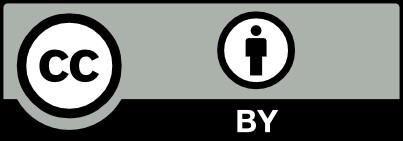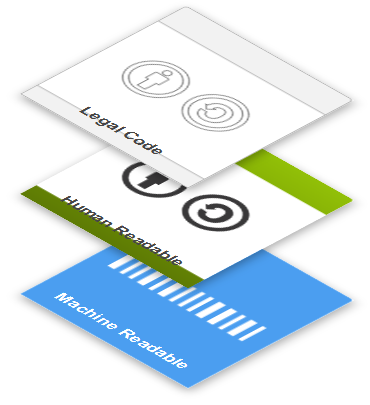Four elements
A CC licence is made up of four different elements. These elements can be combined to create six types of licenses, which tell us what type of use is allowed, and on what terms.
| Norwegian | English | Explanation | |
|---|---|---|---|
| Navngivelse | Attribution (BY) | All licenses have this element, and means that there is always a requirement for authors to be cited. | |
| DelPåSammeVilkår | ShareAlike (SA) | Sharing of adaptations must be done with the same license, or another compatible license. One can therefore say that it protects the openness of further sharing. | |
| IkkeKommersiell | NonCommercial (NC) | The original work, or any adaptations can not be used commercially. | |
 |
IngenBearbeidelser | NoDerivatives (ND) | Adaptations of the original work can not be shared. |
Six licenses
By combining the four elements in different ways, we get licenses that tell us whether the work can be used commercially, if it can be adapted, and on what terms. All licences have the requirement of attribution (BY), and all licenses allow copying and distribution of the work. The six licenses can be said to be in degrees of openness, from more to less open. Publishers usually do not offer all the licenses when you publish Open Access. It is often the most open license offered (CC BY), in addition to one of the more restrictive.
Attribution (CC-BY):
 This license allows for reuse in any way, as long as the author is cited. This means that one can use the work commercially. It is also allowed to share adaptations of the work, which in an academic context could be translations into other languages, using the work in Open Educational Resources (OER), as well as the reuse of figures and graphs (unless these have separate licenses).
This license allows for reuse in any way, as long as the author is cited. This means that one can use the work commercially. It is also allowed to share adaptations of the work, which in an academic context could be translations into other languages, using the work in Open Educational Resources (OER), as well as the reuse of figures and graphs (unless these have separate licenses).
Attribution-ShareAlike (CC BY-SA):
 This license allows for the use and sharing on the same terms as CC BY, but any adaptation must be shared with the same, or compatible license.
This license allows for the use and sharing on the same terms as CC BY, but any adaptation must be shared with the same, or compatible license.
Attribution-NonCommercial (CC BY-NC):
 This license allows others to use the work as they wish, as long as it is not commercial. The use must therefore not be intended for, or directed towards commercial advantage or monetary compensation.
This license allows others to use the work as they wish, as long as it is not commercial. The use must therefore not be intended for, or directed towards commercial advantage or monetary compensation.
Attribution-NonCommercial-ShareAlike (CC BY-NC-SA):
 This is a combination of the previous two licenses, and does not allowed for use of the work commercially, and any non-commercial adaptation must be shared with the same, or compatible license.
This is a combination of the previous two licenses, and does not allowed for use of the work commercially, and any non-commercial adaptation must be shared with the same, or compatible license.
Attribution-NonDerivatives (CC BY-ND):
 This license allows others to use the work as they wish, but it is not allowed to share adaptations of the work.
This license allows others to use the work as they wish, but it is not allowed to share adaptations of the work.
Attribution-NonCommercial-NonDerivatives (CC BY-NC-ND):
 This is the most restrictive license. It does not allow for sharing of adaptations, nor commercial use. With both NonDerivatives licenses, it is the sharing of the adaptation that is not allowed. It therefore still provides the opportunity, as with other licenses, for text and data mining, in case of CC BY-NC-ND, if it is not used commercially, nor shared with others.
This is the most restrictive license. It does not allow for sharing of adaptations, nor commercial use. With both NonDerivatives licenses, it is the sharing of the adaptation that is not allowed. It therefore still provides the opportunity, as with other licenses, for text and data mining, in case of CC BY-NC-ND, if it is not used commercially, nor shared with others.
CC-licenses and author's rights
Even if you give up some rights with CC licenses, it is important to remember that copyright still applies. The same also applies to research ethics, norms and practices. Authors still retain the moral rights to their work, such as the right to be cited, and to protect the integrity of their work. In other words, CC licenses are not a substitute for these, but offers an extra layer of protection. A requirement in all licenses is the author's right to have their name removed from adaptations, for example, in cases where they wish to distance themselves from reuse which suggests support for views they do not stand for. In addition, it is a requirement to indicate in a reasonable manner if changes have been made from the original work, and provide a link back to it, if possible. Intellectual property rights like patent and trademark rights are exceptions to copyright, and are not licensed under CC licenses.
What does derivative mean?
In an academic context, a derivative (to reuse or adapt) could be a translation, reuse of figures, graphs and images (unless these have a separate license), or use of the whole, or parts of the work in Open Educational Resources (OER). If you use a license on you work that does not allow adaptations to be shared, such as CC BY-ND, you can still give permission for such reuse in individual cases, as you would normally do for works without CC licenses.
Plan S
The Research Council of Norway (RCN) is a member of the international coalition, cOAlition S, which is behind Plan S. Due to this, there is a requirement of Open Access in RCN's calls for proposals as of 01.01.2021. This means that for approved project applications for calls after this date, you are required to use a CC license. CC BY or CC BY-SA is allowed. If needed, the use of CC BY-ND is permitted in individual cases. Then this must be justified by the project manager in the project's final report to the RCN. You will find more information about these requirements on our Plan S webpage.
Three layered design

All CC-licenses consist of three layers.
- The first layer is the legal code. This forms the legal basis for the licenses, and contains the terms and conditions.
- The second layer summarizes the legal code of the third layer in a simpler language, making it easier for lay people to understand. This is the layer most of us know.
- The third layer is machine readable, and is written in a format that is understandable by web services, search engines, and many other technologies.